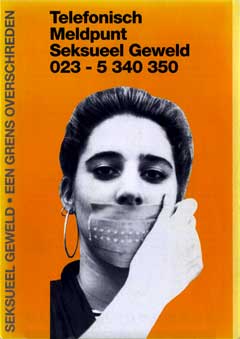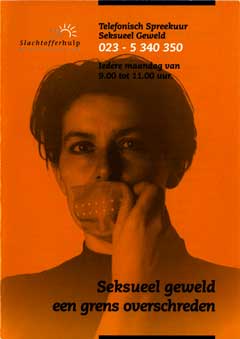CHILD MOLESTER? YOU ARE WELCOME IN THE NETHERLANDS!
How the Netherlands Protects Child Molesters
(source) -- Brought to my attention by a reader--thank you!
If you have followed any of the other documents on this site, you will know that Monique Fasel's original abduction of my daughter's Celina and Stephanie in the first week of January, 1999, was due to the fact that I had caught her sexually molesting one of my daughters on Saturday, January 2, 1999 and informed her that I was taking my daughters to the authorities on Monday, January 4, 1999.
After she abducted the children, I still went to the authorities that I thought might
 handle cases of child molestation. This included the Raad voor de Kinderbescherming (Child Protection Agency), RIAGG (Social Services Agency), the police and our family doctor. At every organization I visited throughout the first two weeks of January I was given the pamphlet to the left. The translation is roughly, "Telephone Emergency-Line for Sexual Abuse." In fact, these pamplets are available at nearly all government social services agencies, all hospitals, all police stations, and all doctors offices in the Haarlem region (including Haarlem, Heemstede, Zandvoort, Overveen, Bentveld, Aerdenhout, and all the little villages within the (023) area code. There are even a few posters resembling this in the train stations.
handle cases of child molestation. This included the Raad voor de Kinderbescherming (Child Protection Agency), RIAGG (Social Services Agency), the police and our family doctor. At every organization I visited throughout the first two weeks of January I was given the pamphlet to the left. The translation is roughly, "Telephone Emergency-Line for Sexual Abuse." In fact, these pamplets are available at nearly all government social services agencies, all hospitals, all police stations, and all doctors offices in the Haarlem region (including Haarlem, Heemstede, Zandvoort, Overveen, Bentveld, Aerdenhout, and all the little villages within the (023) area code. There are even a few posters resembling this in the train stations.I immediately started telephoning this number. I phoned every day for several weeks and then dropped off to calling a couple times a week. Every time I called, all I got was the sound of an unconnected number. I made the incorrect assumption that "perhaps the organization is just getting started and hasn't had their phone connected yet."
Naturally, I tried to locate other organizations that handled sexual abuse cases. In the entire country of the Netherlands I could find only one other organization concerned with sexual abuse and that was in Utrecht. They were dedicated exclusively to handling cases involving Catholic priests. Nor were there any numbers in the phone book.
By May 9, 1999 (Mother's Day), I had fallen off to calling the Emergency Line for Sexual Abuse only about once a week. Then, in a fit of pedophilic jealous rage, Monique ripped off one of my fingernails when I tried to put my arm around Celina in a fatherly way at the riding stables. This injury forced me to go to the doctors for emergency treatment immediately.
There I noticed the new "Sexual Abuse, A Border Overstepped" pamplets. Same phone number; slightly different content. And this time, limiting calls to Mondays between 9 and 11 in the morning (once a week, during school hours. Now that makes a lot of sense!)
Interestingly, when I went to the police to file a report Monique's assualt (I had to go to two police stations because the first said they couldn't waste their time on a ripped off fingernail), both police stations also had the new brochures. I phoned the "Hotline" for the next six Mondays at the proscribed times and always got the same "unconnected number" signal.
Now, I began to get suspicious: New brochures, same number, no respo
 nse. I asked myself, "What happens to kids who call this number? What if an abused child can never reach someone to tell his or her story to?" Becauase of my other problems with Monique terrorizing me and the children, I decided to take the matter to the newspaper.
nse. I asked myself, "What happens to kids who call this number? What if an abused child can never reach someone to tell his or her story to?" Becauase of my other problems with Monique terrorizing me and the children, I decided to take the matter to the newspaper.I made an appointment for 10 Monday morning with Peter Van Vanhove, one of the Netherland's foremost investigative reporters. His work in 1997 and 1998 uncovered the sale of toddlers for sexual purposes, and led to the Netherlands finally making child pornography illegal in 1999 (nonetheless, child pornography is still "tolerated" in the Netherlands like just about everything else that is officially illegal).
Yes, the Netherlands was practically the last developed nation to make child pornography illegal, and that, less than a year ago at the time of this writing. It happened just months after they made prostitution legal.
You see, all this time everyone thought prostitution was legal in the Netherlands it was really just another case of police and officials "looking the other way," -- the policy of "tolerance" gone wild. I had him dial the phone number. He handed me the telphone. It was a busy signal. I said, "just my luck, after six months they turned on their phones today." We waited and waited and got nothing but a busy signal. So I went home and tried the number again just to make sure. It still gave the signal of an unconnected number!
I called the telephone company. They informed me that the number had never, ever been connected. I asked, "How can you be sure that the number has never been connected?" to which they replied, "Because it is a reserved number that can only be assigned to an internal phone of a Telephone Centrale" (automated switchboard). I asked them about the busy signal that I had received at the Haalems Dagblad newspaper and they informed me that this was normal behavior.

Anyone calling from with a building that had a Telephone Centrale (just about anyone in the Netherlands who has more than one telephone) would receive a busy signal for that number since it didn't exist on their Centrale system. "But," they assured me, "that specific number can never, ever be reached from an outside line. Only callers from the same Telephone Centrale could ever reach that number."It's not like America where you can often subsititute a person's extension for the last 3 or 4 digits of a company phone number and then get directly to the person. It simply doesn't work that way in the Netherlands.
Analysis
I returned to the doctor's office and the police station and asked "How do these pamplets get here anway?" I was informed that "People from the organizations bring them in. Anyone can put a stack of pamplets in the pamplet racks." I calculated that it would take about 15,000 pamplets to cover the region where I had observed these pamplets - all the police stations, doctors offices, and social services offices in the (023) area code. I never determined if the scam extended beyond that region.
For less than $5000 in printing costs, a group of child molesters (or one rich one) could print and distribute these flyers and make the public and officials believe that the problem was being dealt with, while leaving the children, the victims, with no one to turn to and the molesters free to do as they like. And any organizations trying to reach the "Hotline" on behalf of a child would simply get a busy signal.
That's one scenario. The other is that people in the Dutch government are themselves involved in this subterfuge. The Netherlands has one of the highest rates of incest and child molestation in the world, it is practically accepted as the norm there -- everyone is "looking the other way" in support of the Dutch policy of tolerance.
In 1993, the Dutch laws were changed making it a crime to have sex with a child under the age of 12, and giving children 16 and over complete sexual freedom. The "grey area" between the ages of 12 and 16 allows children to have consentual sex, and provides that the only person who can lodge a complaint for unconsensual sex is the parent. How's that for a formula for incest?
Author David Farer in his book "Bordel Leven" (Brothel Lives) a scholarly examination of the Dutch prostitution industry (prostitution is completely legal in Holland) states that, of the thousands of prostitutes he interviewed while researching his book, every one of them claimed to have been molested as a child.
On November 4, 1999, an official U.S. Embassy summary of the Dutch newspapers stated: "All papers report extensively on a current parliamentary debate on how to deal with offenders who are found guilty of child abuse. JM Korthals is still working on an official response to recent UN criticism of the way the Netherlands is tackling children's rights. The UN committee on children's rights told the Netherlands it had to take urgent action, and suggested implementing structural measures to ensure children are safe from harm.
Annually, on average, eighty Dutch children are murdered by their parents or guardians, and between 40,000 and 80,000 children are abused, according to figures released by the ministry of health.
I wonder how high those figures would be if children could telephone a Sexual Abuse Hotline that was actually attached to another telephone on the other end of the line. The greater Haarlem region (the "Randstadt") is one of the most populos in the country of the Netherlands.









No comments:
Post a Comment